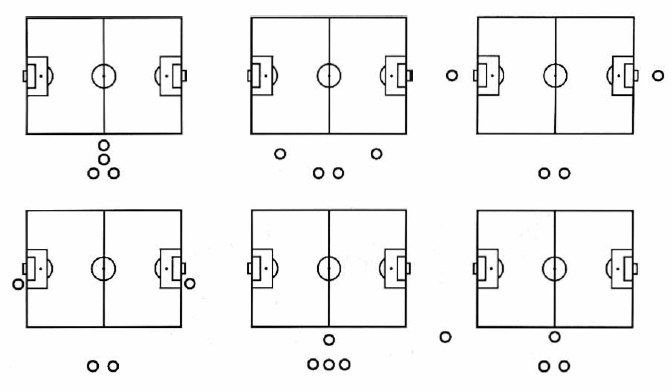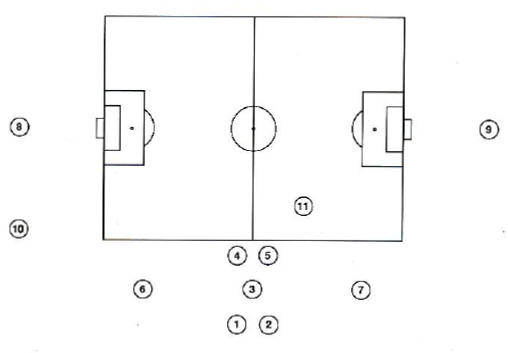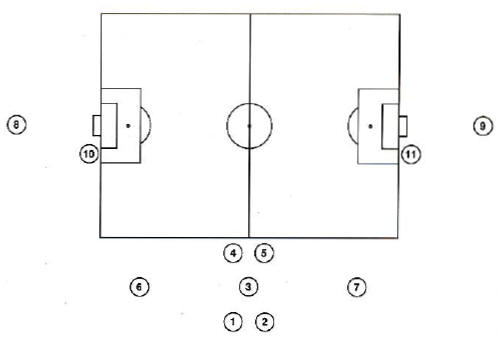Flashback on the the 1990 World Football Cup
The television production model for the World Cup
As it is not possible for me describe, in the small ace imparted, the iought processes that we applied in designing the production model for Italia ‘90, I shall endeavour to summarize the individual steps I feel to be more significant, hoping that by the end I shall have provided an overall picture.
The parameters to which we had to refer when determining a model for producing the coverage of the 1990 World Cup were several: historical precedents, the current production standards for football, advances in coverage technology, the particular type of audience for the event.
The Production Group of which I was coordinator laid down a three-phase programme: a research period for 1988, an experimental and practice period that lasted all through 1989, and the choice of the coverage model in accordance with the corporate editorial line, in 1990.
First phase: 1988
We did not manage to define the characteristics of audience for a World Football Cup. In order to gain an understanding of the coverage problems, I collected the documents summarizing the topics of the international debate on television coverage of football, ranging from the First Convention of Buenos Aires in 1977 to TVF’s documentation for the 1982 World Cup and the proceedings of the 1987 Berlin Seminar, in which I had participated. On that occasion I had proposed a semiotic system of the game on television, a description of the framing of the shots and the approach to producing the sequences of a televised match, which would then have become the theoretical scaffolding of our production model.
The central problem in the debate on the television coverage of a match can be reduced to the dichotomy of television as a reporter/television as an interpreter.
This conflict subtends the role that television has to assume with respect to the event: whether it should consider itself a window on the football field, without influence or supposed to be so, or whether it should have the task of interpreting the match, and within what limits. The dilemma has a wealth of implications and raises concrete problems as to production: one or more viewing positions (and hence the number and position of the cameras), the relative importance of the informational and emotional content (and hence the use of the cameras and replay), the function of computer graphics, the pace of the coverage, the commentator’s role.
Some of these problems were raised on Capri, in June 1988, at a meeting with the foreign sporting press organized by the Local Organizing Committee (LOC).
Throughout 1988, the Group initiated a series of specific research activities associated with the television production of the World Cup. We acquired a collection of books, built up a video library, organized think tanks on some aspects of the history of football with respect to television, postulated the use of advanced technology, did a course on stereophonic sound coverage, explored the problems associated with HDTV, began to tackle the problems of graphics, computers, and play analysis, and studied the reactions of the public and the characteristics of sports installations with respect to broadcast coverage.
In this context, the style or language’ of the broadcast coverage was closely studied. At that time, our investigations distinguished between:
- play with the ball in motion, to be shot just with the camera placed on the halfway line;
- play with the ball motionless, which allowed greater stylistic flexibility, with the shots taken from more than one camera;
- coverage that can be shot with non-central cameras and relating to the condition of play with the ball in motion.
We further distinguished between collective and individual play, and also between play and position of waiting for the ball. We singled out the protagonists of every action in the game, both on and off the pitch. In the end, we had our coverage alphabet.
In parallel with this research, we experimented freely with three or four cameras and one or two replay machines, using single cameras or groups of cameras as part of a hypothetical complete layout (Right: some examples of camera positions).

At the end of the year we presented our theoretical (untried) production model with a basic installation of 11 cameras and four replay machines.

1 - All game camera
2 - Wide camera
3 - Intermediate camera
4 e 5 - Personalities
6 e 7 - 16 m. cameras
8 e 9 - Back goals Cameras
10 - Diagonal camera
11 - Mobile camera
Second phase: 1989
Experiment and practice are two sides of the same coin. It is a matter of trying out the theoretical production model with a pilot installation and of training the operating personnel — directors, cameramen, mixers, replay operators — on this model.
The roles assigned to the cameras were agreed between the directors and were set out in a document at the beginning of 1989. In detail, the following pictures were available to us in the playing area:
- long shot and close-up of any action;
- for a foul: the person fouled against, the person committing the foul, and the referee;
- for a free kick: the player taking it, the ‘barrier’, the goalkeeper, the player marked;
- for a kick-off: the player kicking off, the wait for the ball to be in play;
- for touch: the player who has sent the ball out, the player throwing in, the wait for the ball to be in play;
- for a corner kick: the player kicking, the waiting in the penalty area, marking;
- for shots at goal or goals scored: the player shooting, the goalkeeper, the player who has contributed, or the defender.
Outside the playing area itself, the cameras not used for the action covered the linesmen and the spectators, and a mobile camera the bench and any substitutes sent on.
Training was organized in real course units of two or three days’ duration, using audiovisual material prepared for the occasion. The 50-odd games provided in these courses familiarized the cameramen with the language of the pictures and the directors with the grammar of the sequences. The final result of the training was to make the theoretical production model operational.
Through the trials we were able to fine-tune the definition of the installations and the style of coverage.
The installations were supplemented by two ground-level cameras alongside the goals. Our coverage angle was widened to 180.

Definitive accommodation: 10/11 cameras
We had two or three ways of seeing the game with the ball in motion. The action in the penalty area could be followed with the camera at the 18-yard line, with a sequence passing from a central long shot (2) to a long shot at the 18-yard line (6 or 7) through a close shot (1 or 4 or 5).
When the ball was not moving, all the protagonists of the action were under the cameras. A goal kick could be shown in six or seven different ways; the preparation of a free kick allowed for unusual shots of the players positioned on the pitch; after a goal we were able to show all the protagonists, including the reaction of those on the bench and the spectators. Moreover, adding the two cameras alongside the goals further enriched the stylistic possibilities: the informative value of the long shot by a camera placed high up and a fair distance from the pitch could be alternated with the emotional force of close-ups by ground-level cameras close to the action.
To deal with specific problems, such as stereo sound transmissions, computers and computer graphics, HDTV, and the sports installations, we set up four working groups.
Stereo sound was necessary in connection with the HDTV coverage and to enhance the sound coverage in general. Very often microphones are positioned in stadia to reproduce the ‘condition of the spectator in the stands’ rather than to give a specific sound character to each shot. The Technical Directorate tried out a setup with 14 microphones connected to a switching panel and solved the problem in most of the stadia.
The computer graphics project relied on advanced technology. The computer looked after the statistics and the graphics found their own characteristic element in movement. Statistical data and moving graphics had then to contend with the time-scale of football, which as we all know, is tight and inflexible.
HDTV coverage was already one of the RAJ’s strong points. As the technological limits are changed, not only the approach itself is changed, but also the very philosophy of the presence of television in a stadium. The ambivalence of television as a reporter or an interpreter is typical of the current standard; once the standard has been superseded, so has the style of coverage and a new one has to be sought.
Many of the Italia ‘90 stadia were made available barely in time for the World Cup. We set out the cameras on the basis of the plans, without being able to make sure directly that the positions were correct or the pictures clean. I don’t think, however, that if the stadia had been ready earlier we should have been able to improve the results much: the architecture of sports installations does not make sufficient allowance for the requirements of television.
These and other matters were discussed at the seminar organized by the RAI in Verona to explain the the system of covering the matches for Italia ‘90. Comparison with the experience gained in other countries confirmed for us the stylistic evolution of the television coverage of football and our general layout. The transmission format was laid down as incorporating 13 minutes before the match and three minutes afterwards, including flash interviews. At the end of both halves, the RAI broadcast a summary of highlights, backed up in part with action replays, statistics, and Telebeam.
Third phase: 1990
In February 1990, once the experimental and training phase was over, the five production teams that were to work in the 12 stadia were formed. Every producer had four or five matches to refine the coverage system, in accordance with an editorial line that the RAI management set forth at weekly meetings.
The basic layout was definitely set at 12 cameras and five replay machines; continuity and complete information were laid down as priority aims. To this end, the framing of the long shots of play was made more flexible and the appropriate frequency for cutting between cameras was found. Match coverage thereby became more fluid and the pictures more carefully selected. The function of the medium-shot (or ‘waiting’ or ‘referee’) camera was re-examined and it was given the main job of documenting the referee’s decisions. Special care was taken to establish the suitability, timing, and conditions of use of the instant replay. Lastly, the television commentary was examined in the context of stereo sound coverage.
An increase in the amount of technical facilities was planned for the opening match and the finals. Every director added to the facilities in the stadia in which he was working according to the possibilities allowed him.
We didn’t get permission to place a tiny camera shooting through the meshes of the net in order to have the whole goalmouth in wide angle, nor, in view of the delay in the restructuring of the stadin, were we able to consider systematically the use of moving cameras (dollies, sky-cam). We had a Steadicam for the presentation of the teams and we used the helicopter for a bird’s eye view of the sports installations. Cameras on remote-controlled pan-and-tilt heads were used, and in one stadium it was possible to place one in an azimuthal position with respect to the pitch. Other cameras were used on telescopic supports; in two stadia we managed to use a trolley with a six-metre arm for goal kicks and action in the penalty area; some cameras were positioned outside the grounds to shoot local reactions after the match.
We have no statistics on the impact of the transmissions from the huge television sound stage that was Italy ‘90. The appraisals we have gleaned from the representatives of the broadcasting organizations present and from the public and the Italian press were generally favourable.
It is quite likely that our World Cup coverage did not have a uniformity of style in all the stadia. Slight differences in camera positions, different framing of shots, non-identical layouts, and differing artistic sensitivities on the part of the directors, all favoured a certain variety of narrative. In respect of the criticisms (not many), these were (conflicting) questions of degree: too much detail for some, dullness of reporting for others; not enough replays or too many replays. A matter of opinion. All these comments may be fair, seeing that they referred to different games and different directors. I think, however, that the notorious antinomy between reporting and interpreting is not extraneous to this criticism. I feel that one should do away with it by setting against it the criteria of congruence between coverage and the action of the game.
It is against this yardstick that the stylistic innovations introduced by this World Cup compared with its predecessors should be evaluated — above all abandoning the central position as the sole viewpoint for the action. The debate must remain open, but I believe that the fact of having reflected on television football, the acquisition of the coverage technology, the construction of the stylistic language, and the reporting of the game, are to be recorded among the positive results of this World Cup.
Giancarlo Tomassetti
coordinated the Production
Group set up by the RAI in 1988
info@sportregiatv.it